change time FORD MUSTANG 2022 Warranty Guide
[x] Cancel search | Manufacturer: FORD, Model Year: 2022, Model line: MUSTANG, Model: FORD MUSTANG 2022Pages: 81, PDF Size: 1.96 MB
Page 1 of 81
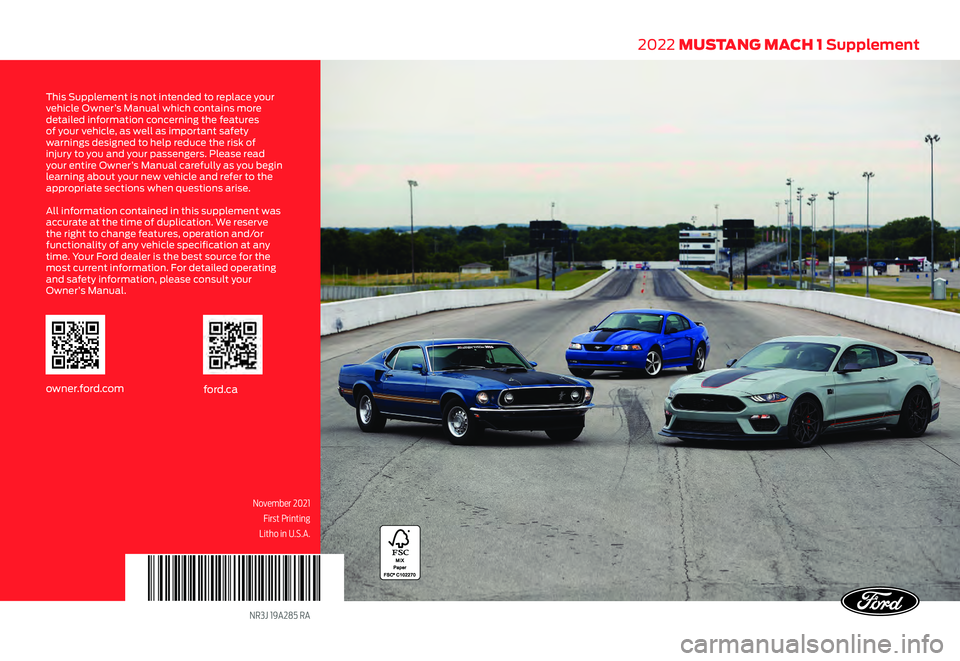
NR3J 19A285 RA
owner.ford.comford.ca
Litho in U.S.A.
This Supplement is not intended to replace your
vehicle Owner’s Manual which contains more
detailed information concerning the features
of your vehicle, as well as important safety
warnings designed to help reduce the risk of
injury to you and your passengers. Please read
your entire Owner’s Manual carefully as you begin
learning about your new vehicle and refer to the
appropriate sections when questions arise.
All information contained in this supplement was
accurate at the time of duplication. We reserve
the right to change features, operation and/or
functionality of any vehicle specification at any
time. Your Ford dealer is the best source for the
most current information. For detailed operating
and safety information, please consult your
Owner’s Manual.
2022 MUSTANG MACH 1 Supplement
November 2021
First Printing
Page 2 of 81
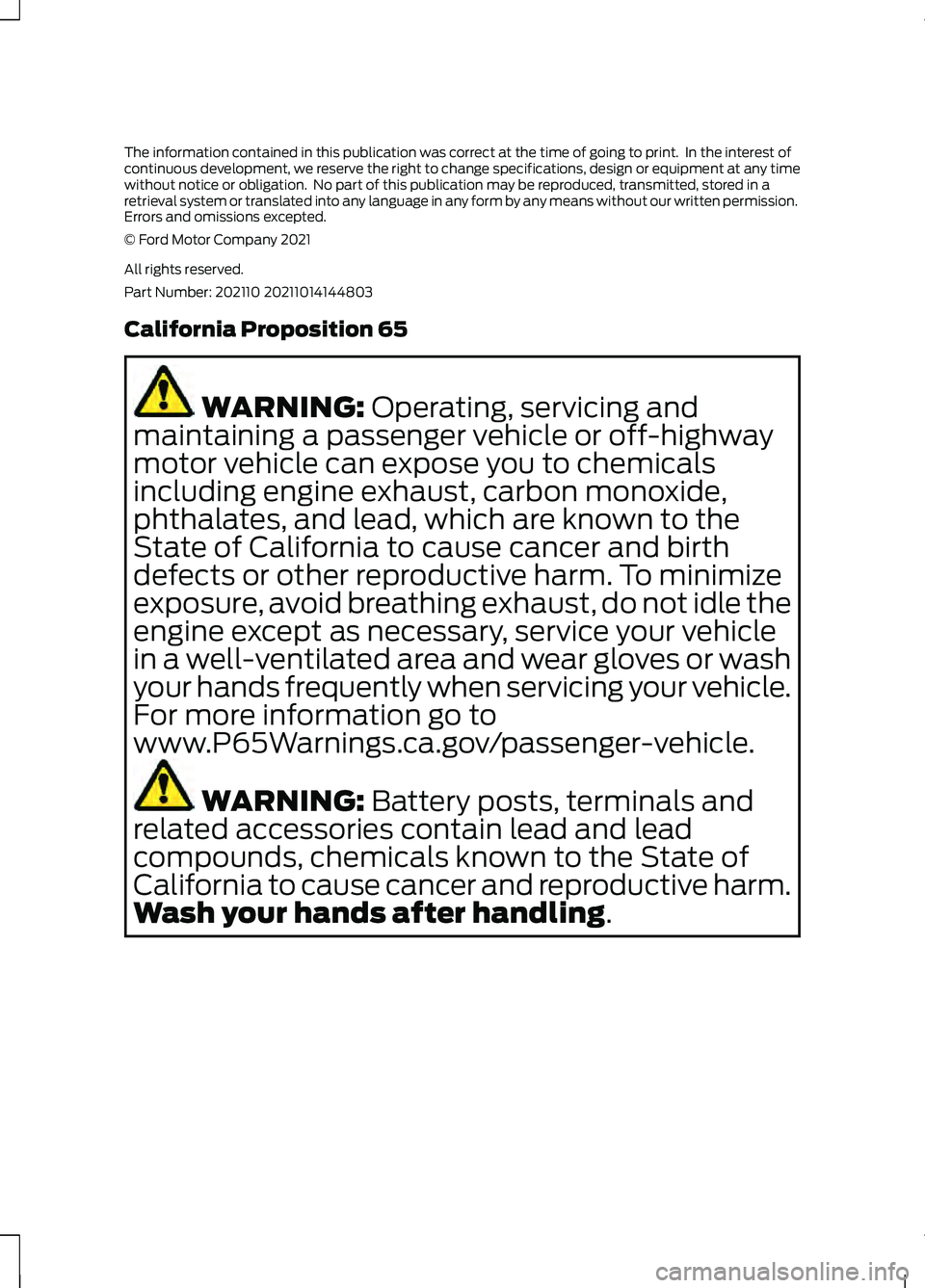
The information contained in this publication was correct at the time of going to print. In the interest of
continuous development, we reserve the right to change specifications, design or equipment at any time
without notice or obligation. No part of this publication may be reproduced, transmitted, stored in a
retrieval system or translated into any language in any form by any means without our written permission.
Errors and omissions excepted.
© Ford Motor Company 2021
All rights reserved.
Part Number: 202110 20211014144803
California Proposition 65
WARNING: Operating, servicing and
maintaining a passenger vehicle or off-highway
motor vehicle can expose you to chemicals
including engine exhaust, carbon monoxide,
phthalates, and lead, which are known to the
State of California to cause cancer and birth
defects or other reproductive harm. To minimize
exposure, avoid breathing exhaust, do not idle the
engine except as necessary, service your vehicle
in a well-ventilated area and wear gloves or wash
your hands frequently when servicing your vehicle.
For more information go to
www.P65Warnings.ca.gov/passenger-vehicle. WARNING:
Battery posts, terminals and
related accessories contain lead and lead
compounds, chemicals known to the State of
California to cause cancer and reproductive harm.
Wash your hands after handling
.
Page 7 of 81
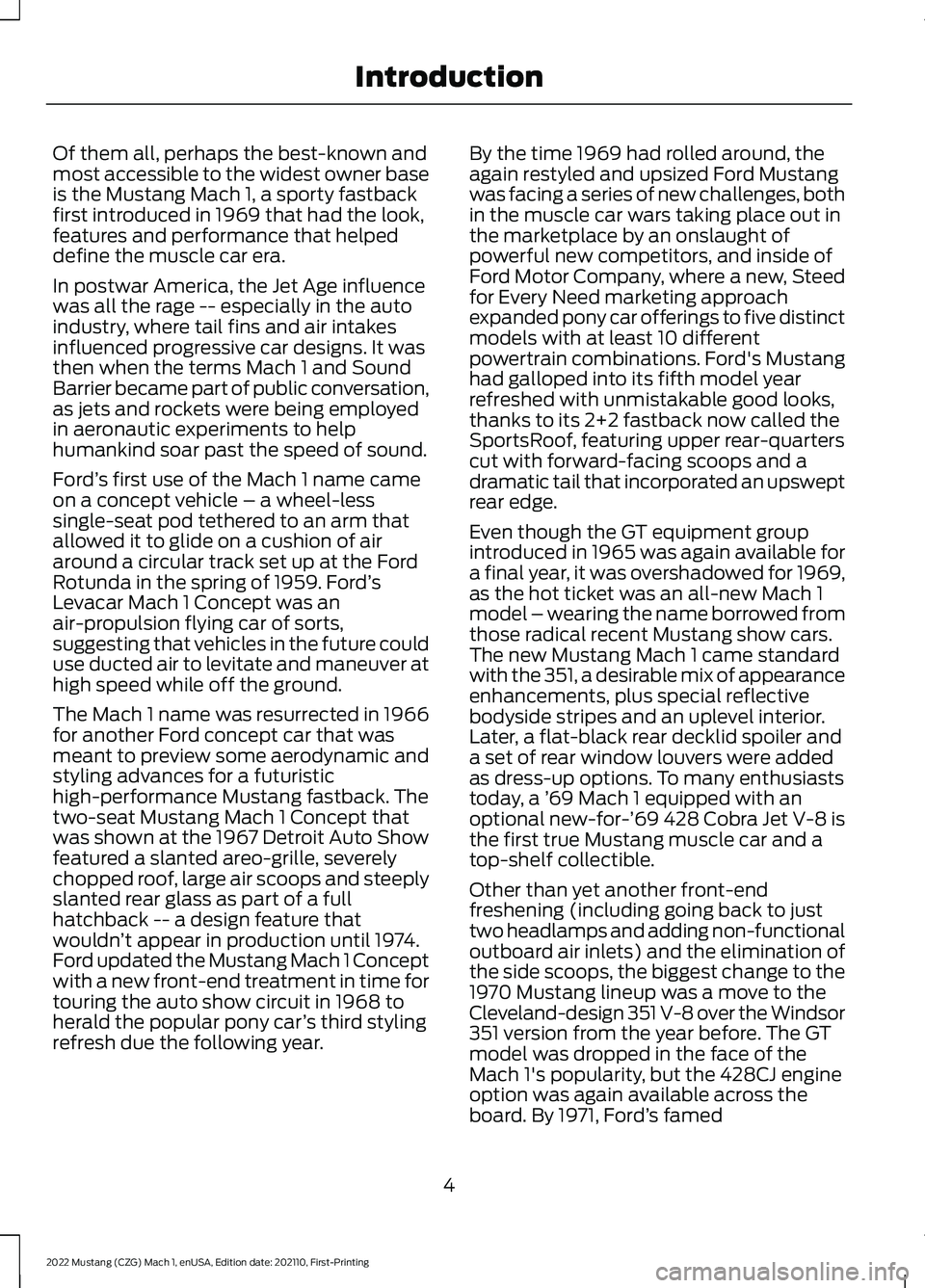
Of them all, perhaps the best-known and
most accessible to the widest owner base
is the Mustang Mach 1, a sporty fastback
first introduced in 1969 that had the look,
features and performance that helped
define the muscle car era.
In postwar America, the Jet Age influence
was all the rage -- especially in the auto
industry, where tail fins and air intakes
influenced progressive car designs. It was
then when the terms Mach 1 and Sound
Barrier became part of public conversation,
as jets and rockets were being employed
in aeronautic experiments to help
humankind soar past the speed of sound.
Ford
’s first use of the Mach 1 name came
on a concept vehicle – a wheel-less
single-seat pod tethered to an arm that
allowed it to glide on a cushion of air
around a circular track set up at the Ford
Rotunda in the spring of 1959. Ford ’s
Levacar Mach 1 Concept was an
air-propulsion flying car of sorts,
suggesting that vehicles in the future could
use ducted air to levitate and maneuver at
high speed while off the ground.
The Mach 1 name was resurrected in 1966
for another Ford concept car that was
meant to preview some aerodynamic and
styling advances for a futuristic
high-performance Mustang fastback. The
two-seat Mustang Mach 1 Concept that
was shown at the 1967 Detroit Auto Show
featured a slanted areo-grille, severely
chopped roof, large air scoops and steeply
slanted rear glass as part of a full
hatchback -- a design feature that
wouldn ’t appear in production until 1974.
Ford updated the Mustang Mach 1 Concept
with a new front-end treatment in time for
touring the auto show circuit in 1968 to
herald the popular pony car ’s third styling
refresh due the following year. By the time 1969 had rolled around, the
again restyled and upsized Ford Mustang
was facing a series of new challenges, both
in the muscle car wars taking place out in
the marketplace by an onslaught of
powerful new competitors, and inside of
Ford Motor Company, where a new, Steed
for Every Need marketing approach
expanded pony car offerings to five distinct
models with at least 10 different
powertrain combinations. Ford's Mustang
had galloped into its fifth model year
refreshed with unmistakable good looks,
thanks to its 2+2 fastback now called the
SportsRoof, featuring upper rear-quarters
cut with forward-facing scoops and a
dramatic tail that incorporated an upswept
rear edge.
Even though the GT equipment group
introduced in 1965 was again available for
a final year, it was overshadowed for 1969,
as the hot ticket was an all-new Mach 1
model – wearing the name borrowed from
those radical recent Mustang show cars.
The new Mustang Mach 1 came standard
with the 351, a desirable mix of appearance
enhancements, plus special reflective
bodyside stripes and an uplevel interior.
Later, a flat-black rear decklid spoiler and
a set of rear window louvers were added
as dress-up options. To many enthusiasts
today, a ’
69 Mach 1 equipped with an
optional new-for-’ 69 428 Cobra Jet V-8 is
the first true Mustang muscle car and a
top-shelf collectible.
Other than yet another front-end
freshening (including going back to just
two headlamps and adding non-functional
outboard air inlets) and the elimination of
the side scoops, the biggest change to the
1970 Mustang lineup was a move to the
Cleveland-design 351 V-8 over the Windsor
351 version from the year before. The GT
model was dropped in the face of the
Mach 1's popularity, but the 428CJ engine
option was again available across the
board. By 1971, Ford ’s famed
4
2022 Mustang (CZG) Mach 1, enUSA, Edition date: 202110, First-Printing Introduction
Page 8 of 81
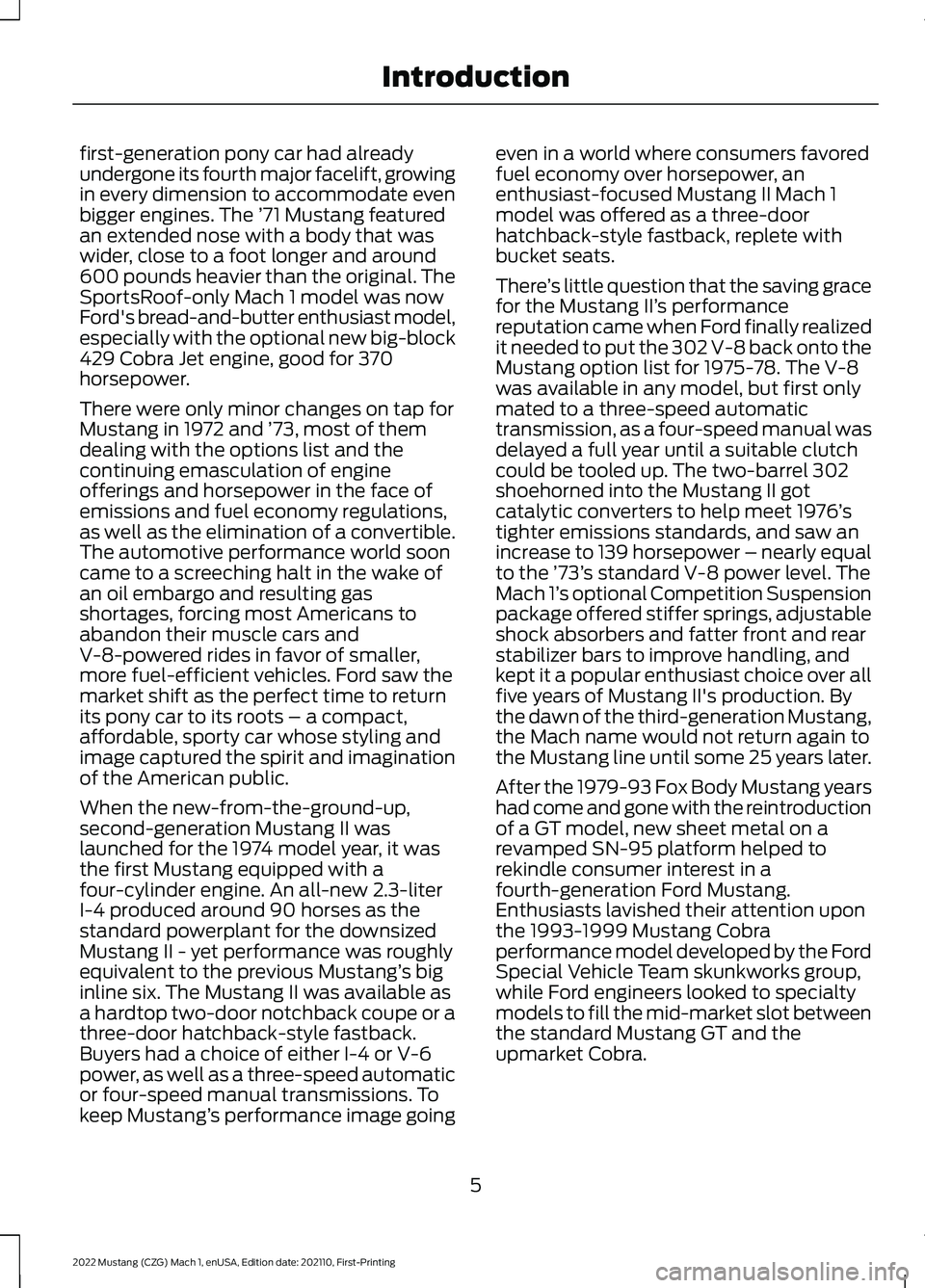
first-generation pony car had already
undergone its fourth major facelift, growing
in every dimension to accommodate even
bigger engines. The ’
71 Mustang featured
an extended nose with a body that was
wider, close to a foot longer and around
600 pounds heavier than the original. The
SportsRoof-only Mach 1 model was now
Ford's bread-and-butter enthusiast model,
especially with the optional new big-block
429 Cobra Jet engine, good for 370
horsepower.
There were only minor changes on tap for
Mustang in 1972 and ’ 73, most of them
dealing with the options list and the
continuing emasculation of engine
offerings and horsepower in the face of
emissions and fuel economy regulations,
as well as the elimination of a convertible.
The automotive performance world soon
came to a screeching halt in the wake of
an oil embargo and resulting gas
shortages, forcing most Americans to
abandon their muscle cars and
V-8-powered rides in favor of smaller,
more fuel-efficient vehicles. Ford saw the
market shift as the perfect time to return
its pony car to its roots – a compact,
affordable, sporty car whose styling and
image captured the spirit and imagination
of the American public.
When the new-from-the-ground-up,
second-generation Mustang II was
launched for the 1974 model year, it was
the first Mustang equipped with a
four-cylinder engine. An all-new 2.3-liter
I-4 produced around 90 horses as the
standard powerplant for the downsized
Mustang II - yet performance was roughly
equivalent to the previous Mustang’ s big
inline six. The Mustang II was available as
a hardtop two-door notchback coupe or a
three-door hatchback-style fastback.
Buyers had a choice of either I-4 or V-6
power, as well as a three-speed automatic
or four-speed manual transmissions. To
keep Mustang’ s performance image going even in a world where consumers favored
fuel economy over horsepower, an
enthusiast-focused Mustang II Mach 1
model was offered as a three-door
hatchback-style fastback, replete with
bucket seats.
There
’s little question that the saving grace
for the Mustang II’ s performance
reputation came when Ford finally realized
it needed to put the 302 V-8 back onto the
Mustang option list for 1975-78. The V-8
was available in any model, but first only
mated to a three-speed automatic
transmission, as a four-speed manual was
delayed a full year until a suitable clutch
could be tooled up. The two-barrel 302
shoehorned into the Mustang II got
catalytic converters to help meet 1976 ’s
tighter emissions standards, and saw an
increase to 139 horsepower – nearly equal
to the ’ 73’s standard V-8 power level. The
Mach 1’ s optional Competition Suspension
package offered stiffer springs, adjustable
shock absorbers and fatter front and rear
stabilizer bars to improve handling, and
kept it a popular enthusiast choice over all
five years of Mustang II's production. By
the dawn of the third-generation Mustang,
the Mach name would not return again to
the Mustang line until some 25 years later.
After the 1979-93 Fox Body Mustang years
had come and gone with the reintroduction
of a GT model, new sheet metal on a
revamped SN-95 platform helped to
rekindle consumer interest in a
fourth-generation Ford Mustang.
Enthusiasts lavished their attention upon
the 1993-1999 Mustang Cobra
performance model developed by the Ford
Special Vehicle Team skunkworks group,
while Ford engineers looked to specialty
models to fill the mid-market slot between
the standard Mustang GT and the
upmarket Cobra.
5
2022 Mustang (CZG) Mach 1, enUSA, Edition date: 202110, First-Printing Introduction
Page 19 of 81
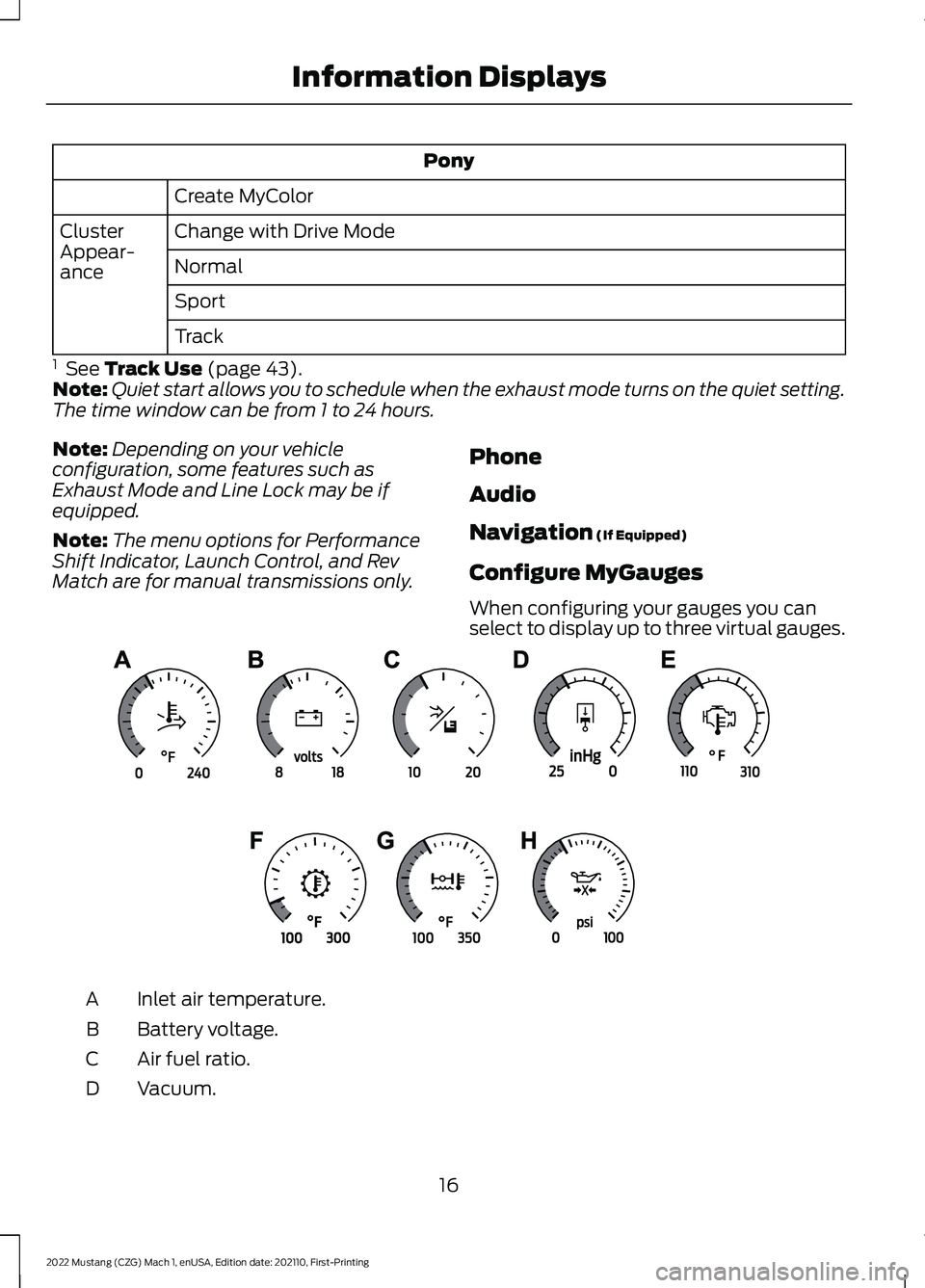
Pony
Create MyColor
Change with Drive Mode
Cluster
Appear-
ance Normal
Sport
Track
1 See Track Use (page 43).
Note: Quiet start allows you to schedule when the exhaust mode turns on the quiet setting.
The time window can be from 1 to 24 hours.
Note: Depending on your vehicle
configuration, some features such as
Exhaust Mode and Line Lock may be if
equipped.
Note: The menu options for Performance
Shift Indicator, Launch Control, and Rev
Match are for manual transmissions only. Phone
Audio
Navigation
(If Equipped)
Configure MyGauges
When configuring your gauges you can
select to display up to three virtual gauges. Inlet air temperature.
A
Battery voltage.
B
Air fuel ratio.
C
Vacuum.
D
16
2022 Mustang (CZG) Mach 1, enUSA, Edition date: 202110, First-Printing Information DisplaysE339879
Page 25 of 81
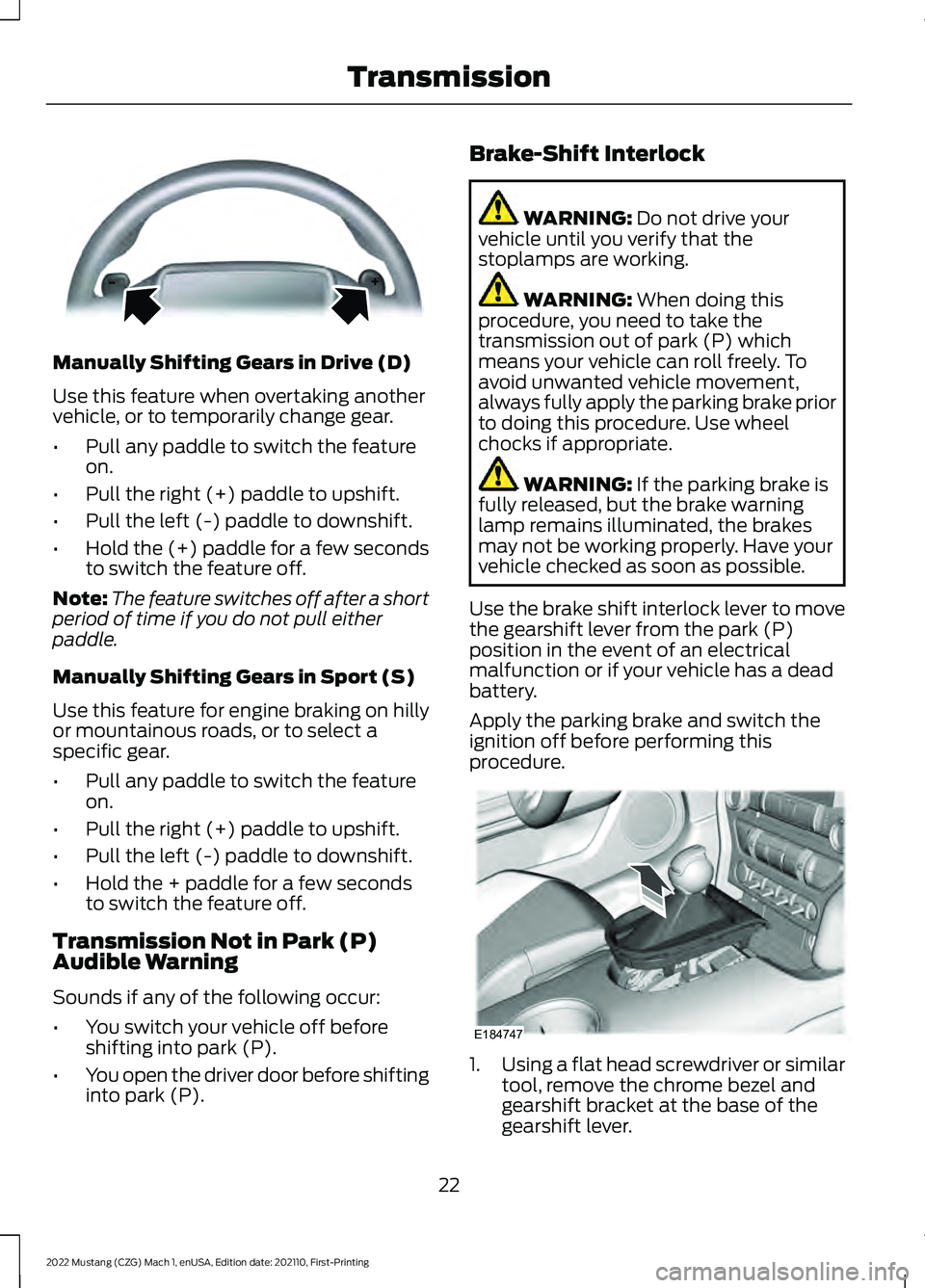
Manually Shifting Gears in Drive (D)
Use this feature when overtaking another
vehicle, or to temporarily change gear.
•
Pull any paddle to switch the feature
on.
• Pull the right (+) paddle to upshift.
• Pull the left (-) paddle to downshift.
• Hold the (+) paddle for a few seconds
to switch the feature off.
Note: The feature switches off after a short
period of time if you do not pull either
paddle.
Manually Shifting Gears in Sport (S)
Use this feature for engine braking on hilly
or mountainous roads, or to select a
specific gear.
• Pull any paddle to switch the feature
on.
• Pull the right (+) paddle to upshift.
• Pull the left (-) paddle to downshift.
• Hold the + paddle for a few seconds
to switch the feature off.
Transmission Not in Park (P)
Audible Warning
Sounds if any of the following occur:
• You switch your vehicle off before
shifting into park (P).
• You open the driver door before shifting
into park (P). Brake-Shift Interlock WARNING: Do not drive your
vehicle until you verify that the
stoplamps are working. WARNING:
When doing this
procedure, you need to take the
transmission out of park (P) which
means your vehicle can roll freely. To
avoid unwanted vehicle movement,
always fully apply the parking brake prior
to doing this procedure. Use wheel
chocks if appropriate. WARNING:
If the parking brake is
fully released, but the brake warning
lamp remains illuminated, the brakes
may not be working properly. Have your
vehicle checked as soon as possible.
Use the brake shift interlock lever to move
the gearshift lever from the park (P)
position in the event of an electrical
malfunction or if your vehicle has a dead
battery.
Apply the parking brake and switch the
ignition off before performing this
procedure. 1.
Using a flat head screwdriver or similar
tool, remove the chrome bezel and
gearshift bracket at the base of the
gearshift lever.
22
2022 Mustang (CZG) Mach 1, enUSA, Edition date: 202110, First-Printing TransmissionE144821 E184747
Page 31 of 81
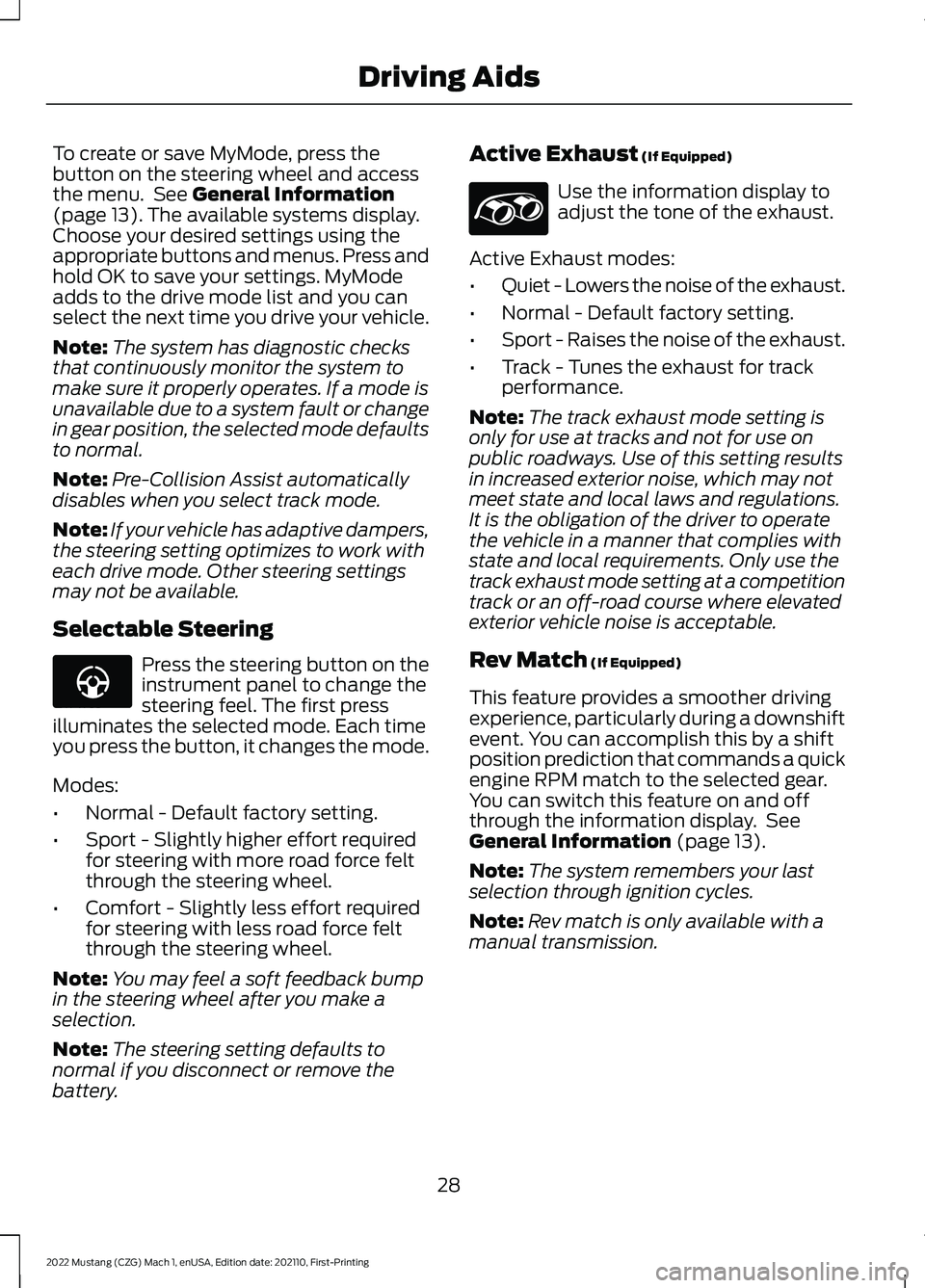
To create or save MyMode, press the
button on the steering wheel and access
the menu. See General Information
(page 13). The available systems display.
Choose your desired settings using the
appropriate buttons and menus. Press and
hold OK to save your settings. MyMode
adds to the drive mode list and you can
select the next time you drive your vehicle.
Note: The system has diagnostic checks
that continuously monitor the system to
make sure it properly operates. If a mode is
unavailable due to a system fault or change
in gear position, the selected mode defaults
to normal.
Note: Pre-Collision Assist automatically
disables when you select track mode.
Note: If your vehicle has adaptive dampers,
the steering setting optimizes to work with
each drive mode. Other steering settings
may not be available.
Selectable Steering Press the steering button on the
instrument panel to change the
steering feel. The first press
illuminates the selected mode. Each time
you press the button, it changes the mode.
Modes:
• Normal - Default factory setting.
• Sport - Slightly higher effort required
for steering with more road force felt
through the steering wheel.
• Comfort - Slightly less effort required
for steering with less road force felt
through the steering wheel.
Note: You may feel a soft feedback bump
in the steering wheel after you make a
selection.
Note: The steering setting defaults to
normal if you disconnect or remove the
battery. Active Exhaust
(If Equipped) Use the information display to
adjust the tone of the exhaust.
Active Exhaust modes:
• Quiet - Lowers the noise of the exhaust.
• Normal - Default factory setting.
• Sport - Raises the noise of the exhaust.
• Track - Tunes the exhaust for track
performance.
Note: The track exhaust mode setting is
only for use at tracks and not for use on
public roadways. Use of this setting results
in increased exterior noise, which may not
meet state and local laws and regulations.
It is the obligation of the driver to operate
the vehicle in a manner that complies with
state and local requirements. Only use the
track exhaust mode setting at a competition
track or an off-road course where elevated
exterior vehicle noise is acceptable.
Rev Match
(If Equipped)
This feature provides a smoother driving
experience, particularly during a downshift
event. You can accomplish this by a shift
position prediction that commands a quick
engine RPM match to the selected gear.
You can switch this feature on and off
through the information display. See
General Information
(page 13).
Note: The system remembers your last
selection through ignition cycles.
Note: Rev match is only available with a
manual transmission.
28
2022 Mustang (CZG) Mach 1, enUSA, Edition date: 202110, First-Printing Driving AidsE174705 E287122
Page 46 of 81
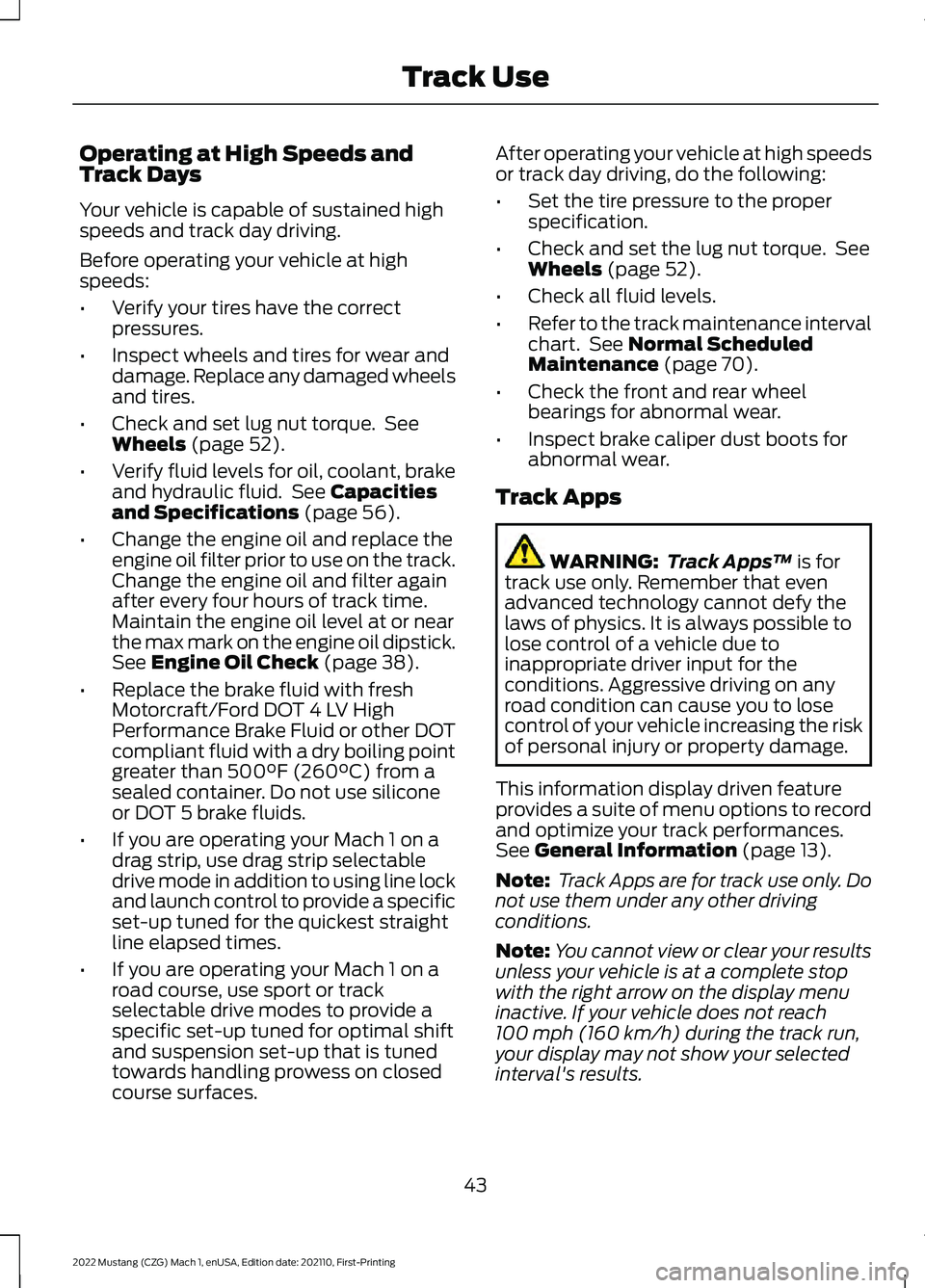
Operating at High Speeds and
Track Days
Your vehicle is capable of sustained high
speeds and track day driving.
Before operating your vehicle at high
speeds:
•
Verify your tires have the correct
pressures.
• Inspect wheels and tires for wear and
damage. Replace any damaged wheels
and tires.
• Check and set lug nut torque. See
Wheels (page 52).
• Verify fluid levels for oil, coolant, brake
and hydraulic fluid. See
Capacities
and Specifications (page 56).
• Change the engine oil and replace the
engine oil filter prior to use on the track.
Change the engine oil and filter again
after every four hours of track time.
Maintain the engine oil level at or near
the max mark on the engine oil dipstick.
See
Engine Oil Check (page 38).
• Replace the brake fluid with fresh
Motorcraft/Ford DOT 4 LV High
Performance Brake Fluid or other DOT
compliant fluid with a dry boiling point
greater than
500°F (260°C) from a
sealed container. Do not use silicone
or DOT 5 brake fluids.
• If you are operating your Mach 1 on a
drag strip, use drag strip selectable
drive mode in addition to using line lock
and launch control to provide a specific
set-up tuned for the quickest straight
line elapsed times.
• If you are operating your Mach 1 on a
road course, use sport or track
selectable drive modes to provide a
specific set-up tuned for optimal shift
and suspension set-up that is tuned
towards handling prowess on closed
course surfaces. After operating your vehicle at high speeds
or track day driving, do the following:
•
Set the tire pressure to the proper
specification.
• Check and set the lug nut torque. See
Wheels
(page 52).
• Check all fluid levels.
• Refer to the track maintenance interval
chart. See
Normal Scheduled
Maintenance (page 70).
• Check the front and rear wheel
bearings for abnormal wear.
• Inspect brake caliper dust boots for
abnormal wear.
Track Apps WARNING:
Track Apps™
is for
track use only. Remember that even
advanced technology cannot defy the
laws of physics. It is always possible to
lose control of a vehicle due to
inappropriate driver input for the
conditions. Aggressive driving on any
road condition can cause you to lose
control of your vehicle increasing the risk
of personal injury or property damage.
This information display driven feature
provides a suite of menu options to record
and optimize your track performances.
See
General Information (page 13).
Note: Track Apps are for track use only. Do
not use them under any other driving
conditions.
Note: You cannot view or clear your results
unless your vehicle is at a complete stop
with the right arrow on the display menu
inactive. If your vehicle does not reach
100 mph (160 km/h)
during the track run,
your display may not show your selected
interval's results.
43
2022 Mustang (CZG) Mach 1, enUSA, Edition date: 202110, First-Printing Track Use
Page 48 of 81
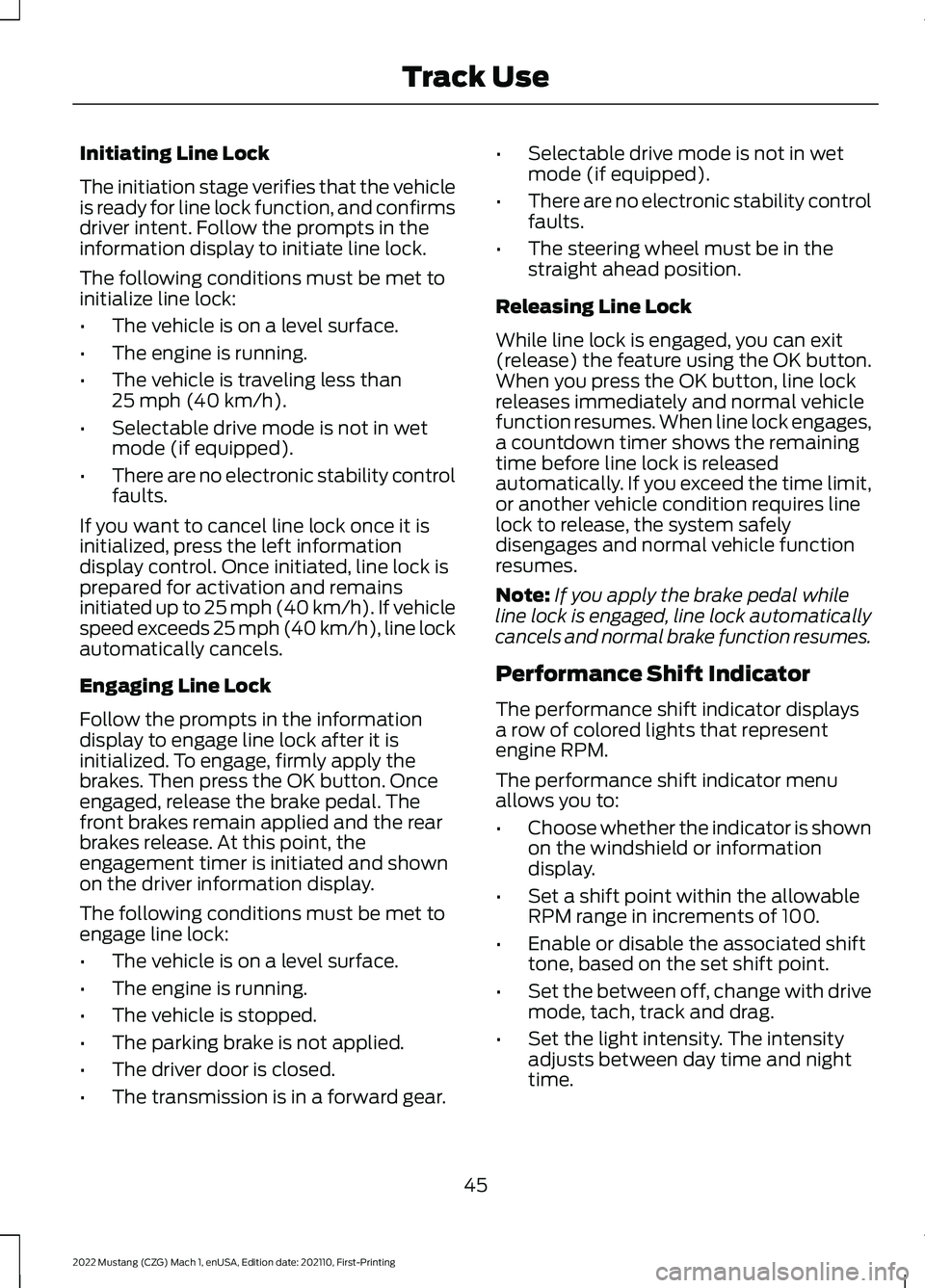
Initiating Line Lock
The initiation stage verifies that the vehicle
is ready for line lock function, and confirms
driver intent. Follow the prompts in the
information display to initiate line lock.
The following conditions must be met to
initialize line lock:
•
The vehicle is on a level surface.
• The engine is running.
• The vehicle is traveling less than
25 mph (40 km/h).
• Selectable drive mode is not in wet
mode (if equipped).
• There are no electronic stability control
faults.
If you want to cancel line lock once it is
initialized, press the left information
display control. Once initiated, line lock is
prepared for activation and remains
initiated up to 25 mph (40 km/h). If vehicle
speed exceeds 25 mph (40 km/h), line lock
automatically cancels.
Engaging Line Lock
Follow the prompts in the information
display to engage line lock after it is
initialized. To engage, firmly apply the
brakes. Then press the OK button. Once
engaged, release the brake pedal. The
front brakes remain applied and the rear
brakes release. At this point, the
engagement timer is initiated and shown
on the driver information display.
The following conditions must be met to
engage line lock:
• The vehicle is on a level surface.
• The engine is running.
• The vehicle is stopped.
• The parking brake is not applied.
• The driver door is closed.
• The transmission is in a forward gear. •
Selectable drive mode is not in wet
mode (if equipped).
• There are no electronic stability control
faults.
• The steering wheel must be in the
straight ahead position.
Releasing Line Lock
While line lock is engaged, you can exit
(release) the feature using the OK button.
When you press the OK button, line lock
releases immediately and normal vehicle
function resumes. When line lock engages,
a countdown timer shows the remaining
time before line lock is released
automatically. If you exceed the time limit,
or another vehicle condition requires line
lock to release, the system safely
disengages and normal vehicle function
resumes.
Note: If you apply the brake pedal while
line lock is engaged, line lock automatically
cancels and normal brake function resumes.
Performance Shift Indicator
The performance shift indicator displays
a row of colored lights that represent
engine RPM.
The performance shift indicator menu
allows you to:
• Choose whether the indicator is shown
on the windshield or information
display.
• Set a shift point within the allowable
RPM range in increments of 100.
• Enable or disable the associated shift
tone, based on the set shift point.
• Set the between off, change with drive
mode, tach, track and drag.
• Set the light intensity. The intensity
adjusts between day time and night
time.
45
2022 Mustang (CZG) Mach 1, enUSA, Edition date: 202110, First-Printing Track Use
Page 71 of 81
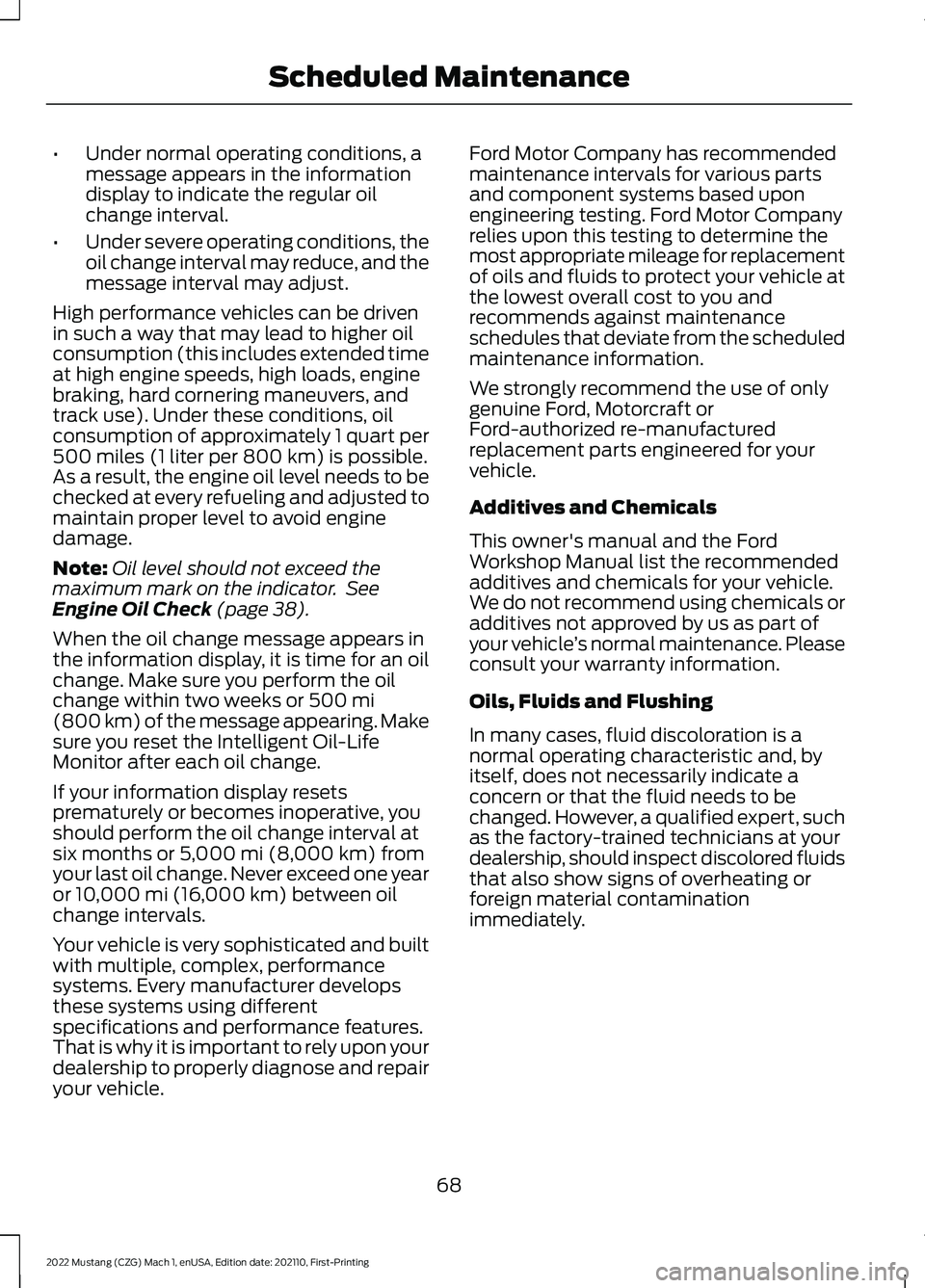
•
Under normal operating conditions, a
message appears in the information
display to indicate the regular oil
change interval.
• Under severe operating conditions, the
oil change interval may reduce, and the
message interval may adjust.
High performance vehicles can be driven
in such a way that may lead to higher oil
consumption (this includes extended time
at high engine speeds, high loads, engine
braking, hard cornering maneuvers, and
track use). Under these conditions, oil
consumption of approximately 1 quart per
500 miles (1 liter per 800 km) is possible.
As a result, the engine oil level needs to be
checked at every refueling and adjusted to
maintain proper level to avoid engine
damage.
Note: Oil level should not exceed the
maximum mark on the indicator. See
Engine Oil Check (page 38).
When the oil change message appears in
the information display, it is time for an oil
change. Make sure you perform the oil
change within two weeks or
500 mi
(800 km) of the message appearing. Make
sure you reset the Intelligent Oil-Life
Monitor after each oil change.
If your information display resets
prematurely or becomes inoperative, you
should perform the oil change interval at
six months or
5,000 mi (8,000 km) from
your last oil change. Never exceed one year
or
10,000 mi (16,000 km) between oil
change intervals.
Your vehicle is very sophisticated and built
with multiple, complex, performance
systems. Every manufacturer develops
these systems using different
specifications and performance features.
That is why it is important to rely upon your
dealership to properly diagnose and repair
your vehicle. Ford Motor Company has recommended
maintenance intervals for various parts
and component systems based upon
engineering testing. Ford Motor Company
relies upon this testing to determine the
most appropriate mileage for replacement
of oils and fluids to protect your vehicle at
the lowest overall cost to you and
recommends against maintenance
schedules that deviate from the scheduled
maintenance information.
We strongly recommend the use of only
genuine Ford, Motorcraft or
Ford-authorized re-manufactured
replacement parts engineered for your
vehicle.
Additives and Chemicals
This owner's manual and the Ford
Workshop Manual list the recommended
additives and chemicals for your vehicle.
We do not recommend using chemicals or
additives not approved by us as part of
your vehicle
’s normal maintenance. Please
consult your warranty information.
Oils, Fluids and Flushing
In many cases, fluid discoloration is a
normal operating characteristic and, by
itself, does not necessarily indicate a
concern or that the fluid needs to be
changed. However, a qualified expert, such
as the factory-trained technicians at your
dealership, should inspect discolored fluids
that also show signs of overheating or
foreign material contamination
immediately.
68
2022 Mustang (CZG) Mach 1, enUSA, Edition date: 202110, First-Printing Scheduled Maintenance